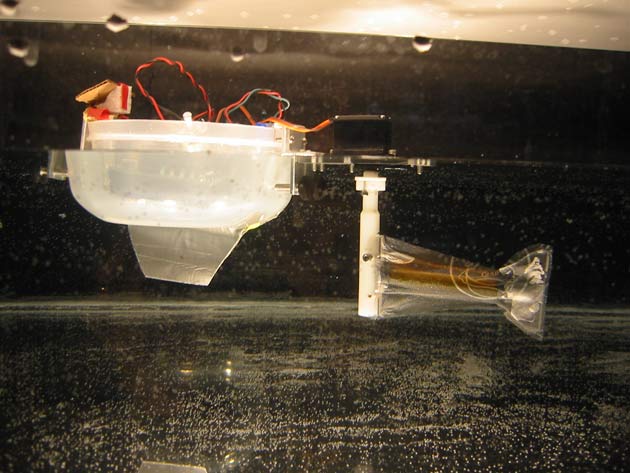Robots 'Mate' and Evolve

Robot tadpole sex might help shed light on how our early ancestors evolved backbones.
The distant forebears of humans and other vertebrates were much squashier than their descendants. They possessed flexible rods known as notochords that served as primitive backbones, but no vertebrae.
Scientists think vertebrae evolved to help our ancient predecessors swim more powerfully by stiffening the body so attached muscles could generate more force.
"The fossil record shows vertebrae evolved independently at least four separate times. That shows they must really be functionally important," said vertebrate physiologist John Long at Vassar College in Poughkeepsie, N.Y.
To test this idea, Long and his colleagues built robot fish with backbones of varying strength to simulate extinct animals. They then "mated" the best swimmers to see how generations of "offspring" evolved to swim better.
Robotic mating
The robot tadpoles [image] are called "Tadros." They were modeled after swimming creatures that still have notochords, the larvae of marine animals known as sea squirts.
Sign up for the Live Science daily newsletter now
Get the world’s most fascinating discoveries delivered straight to your inbox.
Each Tadro had a single electronic eye, a motor, a computerized brain that controlled its motions, and tails made of gelatin of different lengths and stiffness. The robots had bodies between six and seven inches long, with tails two to four inches long, and swam along the surface.
The scientists raced three robots in eight-foot-diameter fish tanks, each zooming to and swimming around a light suspended above the tank. After seeing which fish swam best, the research team "mated" them using computer simulations that modeled the genetic mixing that occurs during sex to produce the next generation of Tadro tails. The best swimmer was given the greatest mating success and chance to pass along its traits, while poorer swimmers had less luck.
After 10 generations, Long and his colleagues found that as swimming performances improved, stiffer tails evolved.
"One thing vertebrates really brought to scene were large, fast, active animals, and this part of the anatomy has a direct connection with that," Long said.
However, Long added their analysis showed increasing tail stiffness accounted for only 40 percent of the improvement in swimming performance, meaning other factors are involved, such as how well the tail turns. "We plan to investigate what that next 60 percent is," Long told LiveScience.
Enter the predator
In addition, the researchers plan on adding a "predator" into the tank during the swimming competition to see how Tadro tails evolve then. This hunter will attempt to collide with the robots, while the Tadros will try to avoid it. This next generation of Tadros will detect the predator using infrared sensors that mimic the pressure-sensitive organs of fish, known as lateral lines.
"We also plan not just on making the backbone stiffer, but on putting in vertebrae, to make them bend, to have joints, and see how that changes things," Long said.
Long and his colleagues reported their findings online Nov. 17 via the Journal of Experimental Biology.











